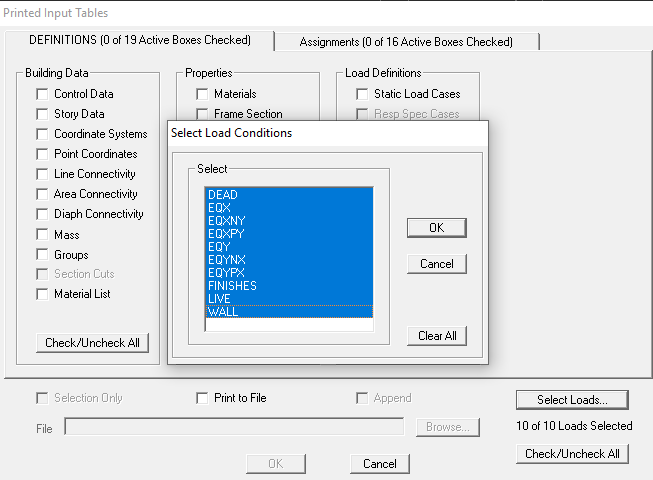-
Posts
74 -
Joined
-
Last visited
-
Days Won
9
asadishaq last won the day on July 1 2020
asadishaq had the most liked content!
Profile Information
-
Gender
Male
-
Location
karachi pakistan
-
University
N.E.D University of Engg.&Technology Karachi
-
Employer
Arif and Associates
-
Interests
structures
Recent Profile Visitors
4,575 profile views
asadishaq's Achievements
-
 asadishaq reacted to a post in a topic:
I want to build 3 floor building on my 128 sqy corner plot
asadishaq reacted to a post in a topic:
I want to build 3 floor building on my 128 sqy corner plot
-
 asadishaq reacted to a post in a topic:
Max Percentage of steel in Columns
asadishaq reacted to a post in a topic:
Max Percentage of steel in Columns
-
 asadishaq reacted to a post in a topic:
Preferable construction joint location in Piled-raft foundation
asadishaq reacted to a post in a topic:
Preferable construction joint location in Piled-raft foundation
-
 UmarMakhzumi reacted to a post in a topic:
Stability Checks In Safe Software
UmarMakhzumi reacted to a post in a topic:
Stability Checks In Safe Software
-
@Hussam Afifyyou can manually apply the overturning check, multiply horizontal load (either from wind or seismic) with the distance from the bottom of the footing to get your overturning moment, and then check against the stabilizing moment i.e (weight of the structure + soil above footing multiplied with their respective lever arms.
- 4 replies
-
- sliding
- overturning
-
(and 1 more)
Tagged with:
-
 Waqar Saleem reacted to a post in a topic:
Etabs model dont show auto seismic calculation in summary report
Waqar Saleem reacted to a post in a topic:
Etabs model dont show auto seismic calculation in summary report
-
 Ayesha reacted to a post in a topic:
Etabs model dont show auto seismic calculation in summary report
Ayesha reacted to a post in a topic:
Etabs model dont show auto seismic calculation in summary report
-
 UmarMakhzumi reacted to a post in a topic:
Etabs model dont show auto seismic calculation in summary report
UmarMakhzumi reacted to a post in a topic:
Etabs model dont show auto seismic calculation in summary report
-

Etabs model dont show auto seismic calculation in summary report
asadishaq replied to kHURRAM ALI's topic in Software Issues
WALEKUM SALAM! Dear Khurram, After running the model go to file menu >Print tables > Input menu and select load options and select all load cases then print the summary, it will show the automatic lateral load calculations -
 asadishaq reacted to a post in a topic:
Understanding Structures with Fawad Najam
asadishaq reacted to a post in a topic:
Understanding Structures with Fawad Najam
-
 Fawad reacted to a post in a topic:
Expansion joints
Fawad reacted to a post in a topic:
Expansion joints
-
 UmarMakhzumi reacted to a post in a topic:
Expansion joints
UmarMakhzumi reacted to a post in a topic:
Expansion joints
-
 EngrJunaid reacted to a post in a topic:
Expansion joints
EngrJunaid reacted to a post in a topic:
Expansion joints
-
Based on Technical Report No. 65, Expansion Joints in Buildings: issued by Building Research Advisory Board, Division of Engineering, National Research Council, USA. As per Figure 1 in the above referenced publication, the maximum allowable building length without use of expansion joints, for design temperature change greater than 70º F (39º C) will be 0.85x350=297.5 ft = 90m. In view of above, we would like to avoid expansion joints in any building which is less than 90m in length, except where a seismic joint is required due to configuration of the building (plan irregularities, re‐entrant corners, etc.) or due to different lateral force‐resisting systems for the two parts of the building.
-
 Fawad reacted to a post in a topic:
Expansion joints
Fawad reacted to a post in a topic:
Expansion joints
-
What is the criteria for providing hanger bars? any code reference etc.?
-
Shrinkage strips are temporary joints that are left open for a certain time during construction to allow the shrinkage to take place without inducing stresses. It is usually 2 to 3 feet wide across the entire building and should be cast 2 to 4 weeks later than the adjacent portions.
-
Vamshi Prasad started following asadishaq
-
Waqar Saleem started following asadishaq
-
 EngrUzair reacted to a post in a topic:
Importing of etabs 9.7.4 file to 2016
EngrUzair reacted to a post in a topic:
Importing of etabs 9.7.4 file to 2016
-
 UmarMakhzumi reacted to a post in a topic:
Importing of etabs 9.7.4 file to 2016
UmarMakhzumi reacted to a post in a topic:
Importing of etabs 9.7.4 file to 2016
-
Follow the link below, I hope this will clarify your query. https://wiki.csiamerica.com/display/etabs/ETABS+v7%2C+v8%2C+and+v9+Translator
-
If the frame is located in zone 3 or 4 it should be SMRF, and if it is in zone 2 it should be IMRF.
- 11 replies
-
- structural systems
- ubc 97
-
(and 1 more)
Tagged with:
-
EA consulting is very good organization, they have good projects and have very experienced professionals, working environment is also good they have bridge department and also the building department.On the other hand M&B is equally good as EA they only have Building experts and they are now a days doing very good high rise projects.
-
 asadishaq reacted to a post in a topic:
Beams and Columns Over-stressed Next to Shearwall
asadishaq reacted to a post in a topic:
Beams and Columns Over-stressed Next to Shearwall
-
 asadishaq reacted to a post in a topic:
How to solve bending moment probelm ETABS
asadishaq reacted to a post in a topic:
How to solve bending moment probelm ETABS
-

Beams and Columns Over-stressed Next to Shearwall
asadishaq replied to asadishaq's topic in Software Issues
Dear Umar Bhai, These are the concrete columns,I want to know how should I detail these columns if I provide the hinges in ETABS at top and bottom of the columns. -
Dear All Experts, Can we provide hinges in the columns at top and bottom? I am asking this question in a scenario that my columns are very close to shear walls and are getting very high moments.
-
https://www.csiamerica.com/products/safe/watch-and-learn watch the tutorial for SAFE foundations uplift
- 15 replies
-
Dear All While visiting the site I observed water dipping out from these cracks on the slab soffits,please see the attachment. What type of cracks are these, and are they alarming for us. Type of slabs are two way slabs supported on beams,slab thickness is 8 inches and span is 27 feet by 31 feet. In my understanding these are yield line cracks because they are resembling the yield line patterns. slabcracks.zip
-
Providing 12" PCC cannot controll the settelments because on the application of load this PCC layer will be crushed and will change in to a powder form.
- 2 replies
-
- Fill
- loose soil
-
(and 1 more)
Tagged with:
-
wasalam, Dear Waqar, For allowable deflections of two way slbas please refer to the table 9.5( of ACI 318-08,where you can find the maximum permissble deflections for two way slabs.secondly if you want the procedure how to check, it can be easily done by importing your floor in SAFE where you can check the deflection of slab at any point. Thanks
- 2 replies
-
- two way slab
- allowable deflection
-
(and 1 more)
Tagged with:
-
 asadishaq reacted to a post in a topic:
The Seismic Performance Of Rcc Frame Buildings With Masonry Infill Walls
asadishaq reacted to a post in a topic:
The Seismic Performance Of Rcc Frame Buildings With Masonry Infill Walls
-
 asadishaq reacted to a post in a topic:
Word Spreading This Forum
asadishaq reacted to a post in a topic:
Word Spreading This Forum
-
 asadishaq reacted to a post in a topic:
Free Concrete Design Publications From Pca
asadishaq reacted to a post in a topic:
Free Concrete Design Publications From Pca
-
inter story drift is exceeding in basement levels,also torsional irregularity greatly exists at different levels.should we consider the underground stories for seismic drift and torsion???





